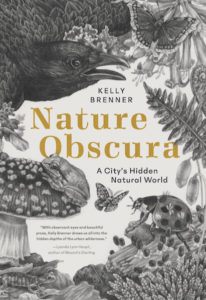There are few nights of my life that I can recall when I have been more scared than I was the night I took up Kelly Brenner’s Nature Obscura. Reports of the SARS-CoV-2 virus spreading throughout the world had suddenly reached fever pitch with case numbers of COVID-19 being reported as skyrocketing where only a few weeks before few if any were known. In my own home country, the administration appeared to be both clueless and feckless in their willingness to take it seriously, or to have any defined plan to do anything meaningful to address it. With our daughter recently returned home from her university, I had the two people I love most in the world by my side, but not the faintest idea of how were were going to make it though what I was chillingly certain would soon become a catastrophe of global proportions.
I needed to find a way to calm myself down at least sufficiently to stop shaking and get some sleep. Nothing I had up to that time been reading could possibly hold my attention – I needed something different, something into which I could (goddess willing) perhaps lose myself in – even if only for a few moments. Picking up Nature Obscura from atop one of the to-be-read stacks, I headed off to lie down and attempt to read. As I quickly discovered, I had made precisely the right choice.
Not more than a few pages in to Ms. Brenner’s delightful and remarkably gentle prose, I found myself being drawn deep into her recounting of the natural history of Anna’s Hummingbirds; her words intricately interweaving academic information about the species with her own experiences observing their habits into a fine tapestry as vibrantly colored as the feathers of her tiny subjects. By the end of the first essay I found that for a few blissful moments the rest of the world had fallen away and I was standing in the sunshine, watching the little birds I too have seen throughout many winters behind our own Oregon home, only I had never before seen them with the astonishingly perceptive gaze Ms. Brenner brings to her observations.
Drawing upon her astonishing fine ability to notice, and find both fascination and enjoyment in, things that are all-too-easily missed in the daily hurly-burly of the modern world – mosses, ferns, crows, muskrats, slime-molds (especially slime-molds) – Ms. Brenner uses her exquisite command of the English language to guide her readers along on a tour of the wonders to be found in the natural world that is not far-off and exotic, but close, easily accessible, and remarkably (for lack of a better word) cozy.
One of my favorites of all the essays collected in this book is “A World in a Petri Dish,” in which she opened my eyes not to only to the extraordinary lives – as well as number of known species (I thought there was only one) – of tardigrades, but taught me the best way to find and keep them as temporary tiny pets. As one who has literally screamed for joy in a crowded convention hall upon finding a tardigrade in a water sample I had mounted into a microscope for a demonstration, her delightfully easy and fruitful technique for discovering them is one I have already employed to great success.
Then there is her “To Be of Not To Be Armored,” a presentation of the evolutionary adaptations of sticklebacks. Two pages into this aquatic revery and I was eight-years-old once again, peering through the planks of the local mooring basin docks into a shaded patch of Columbia River water, watching these spiny little fish flit into an out of my field of vision as they nibbled the algae growing on the dock’s half-submerged supporting floats. Back then I took so much delight in watching these little fish while my father tended to our family’s fishing boat; a delight that I – alas, like so many – one day lost from neglect.
Indeed, while I too formerly possessed an enthusiastic level of perception akin to Ms. Brenner’s; the difference between us, and what makes her such an extraordinary naturalist, is that she apparently not only never lost hers, she has developed, strengthened, and refined it to a level of mastery worthy of both admiration and awe by all those of us who fancy ourselves naturalists.
Whenever I find a book that has touched me deeply, be it intellectually or emotionally, I like to take whatever opportunity I am given to offer a message of gratitude to the author for the education, the enlightenment, or pleasure it has given me, but in regard to Nature Obscura, I am at somewhat of a loss as to how to do so. It is one thing to tell an author that her book was particularly informative, well-written, or a delight to read, but how can one truly convey sufficient gratitude to someone who has written a book that quite truly had the ability to lift one out of a soul-wrenching pit of fear and despair, and carry one away to a place of much-needed respite, where hummingbirds flit and glimmer in the sunshine, lush green moss grows over the roof tiles, and tiny six-legged bears graze peacefully in a little rainwater-filled dish at the corner of one’s desk? The only thing I can think of is, when this is all over, and if I ever meet her in person, I plan to – with her permission, of course – give her an enormous hug.
 Title: Nature Obscura; A City’s Hidden Natural World
Title: Nature Obscura; A City’s Hidden Natural World
Author: Kelly Brenner
Publisher: Mountaineers Books
Format: Paperback
Pages: 208 pp.
ISBN: 978-1-68051-207-6
Published: February 2020
In accordance with Federal Trade Commission 16 CFR Part 255, it is disclosed that the copy of the book read in order to produce this review was provided gratis to the reviewer by the publisher.


March 29, 2020 @ 15:24
I just ordered a copy from Powell’s last night!
April 3, 2020 @ 14:09
A noteworthy review, for the Naturalist’s naturalist book collection; and for rekindling, nurturing and developing that Sense of Awe and Wonder – right in place around you!
One suggestion: BUY from Mountaineer Books (you don’t need to be a member) and you will be supporting a brilliant legacy of writers that pander to one’s own meanderings in the mountains, fields and woods…